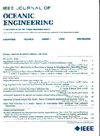The Pulse Signal Reconstruction Method Against Broadband Continuous Wave Interference
IF 5.3
2区 工程技术
Q1 ENGINEERING, CIVIL
引用次数: 0
Abstract
In the acoustic confrontation scenario of noncooperative localization, a ship needs to receive continuous wave (CW) pulse signals from other nodes for localization. At the same time, the ship emits broadband interference used to jam and deceive an enemy ship. The interference creates an extremely strong interference background at the hydrophone close to the ship, thus damaging subsequent localization. Therefore, to localize other nodes, the problem of CW pulse signal reconstruction under strong interference background needs to be solved on a priority basis. Focusing on the signal reconstruction problem under strong interference conditions, this article proposes a parallel convolutional neural network with skip connections. The network mainly consists of a target subnet and an interference subnet. The input to the network contains a CW pulse signal, interference, and background noise. The target subnet is designed to estimate the target component, that is, the CW pulse signal. Additionally, the interference subnet is tasked with estimating the interference component. Ultimately, the acquired target and interference components are used to reconstruct the CW pulse signal of interest. The performance of the proposed network is evaluated using the signal-to-interference ratio (SIR) gain and signal-to-distortion ratio (SDR). According to simulation results, when the input SIR and signal-to-noise ratio are in the range of −8 to 10 dB, the SIR gain and the SDR of our method surpass comparative algorithms. Experimental results show that our network outperforms other benchmark algorithms in reconstructing underwater CW pulse signals with low input SIR. The calculated SIR gain and SDR are 37.80 dB and 6.82 dB, respectively.针对宽带连续波干扰的脉冲信号重构方法
在非合作定位的声对抗场景中,船舶需要接收来自其他节点的连续波脉冲信号进行定位。同时,该舰发射用于干扰和欺骗敌舰的宽带干扰。该干扰在靠近舰船的水听器处产生极强的干扰背景,从而破坏后续定位。因此,为了定位其他节点,需要优先解决强干扰背景下的连续波脉冲信号重构问题。针对强干扰条件下的信号重构问题,提出了一种带跳跃连接的并行卷积神经网络。网络主要由目标子网和干扰子网组成。网络的输入包含连续波脉冲信号、干扰和背景噪声。目标子网被设计用来估计目标分量,即连续波脉冲信号。此外,干扰子网的任务是估计干扰分量。最后,利用获取的目标和干扰分量重构目标连续波脉冲信号。利用信干扰比(SIR)增益和信失真比(SDR)对该网络的性能进行了评价。仿真结果表明,当输入SIR和信噪比在−8 ~ 10 dB范围内时,本文方法的SIR增益和SDR均优于比较算法。实验结果表明,该网络在低SIR输入水下连续波脉冲信号重构方面优于其他基准算法,计算出的SIR增益和SDR分别为37.80 dB和6.82 dB。
本文章由计算机程序翻译,如有差异,请以英文原文为准。
求助全文
约1分钟内获得全文
求助全文
来源期刊

IEEE Journal of Oceanic Engineering
工程技术-工程:大洋
CiteScore
9.60
自引率
12.20%
发文量
86
审稿时长
12 months
期刊介绍:
The IEEE Journal of Oceanic Engineering (ISSN 0364-9059) is the online-only quarterly publication of the IEEE Oceanic Engineering Society (IEEE OES). The scope of the Journal is the field of interest of the IEEE OES, which encompasses all aspects of science, engineering, and technology that address research, development, and operations pertaining to all bodies of water. This includes the creation of new capabilities and technologies from concept design through prototypes, testing, and operational systems to sense, explore, understand, develop, use, and responsibly manage natural resources.
 求助内容:
求助内容: 应助结果提醒方式:
应助结果提醒方式:


